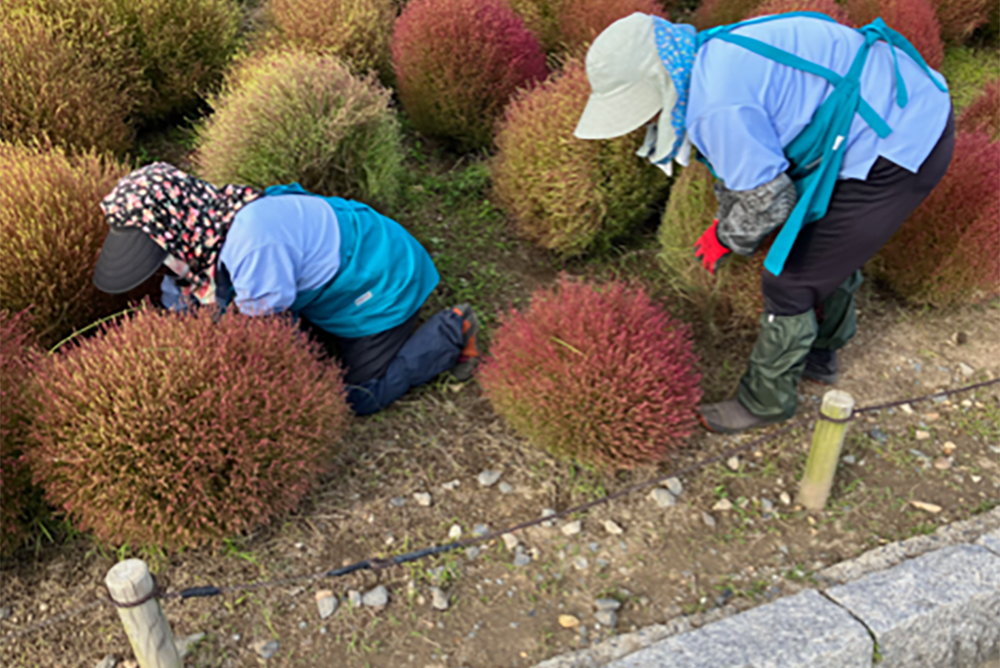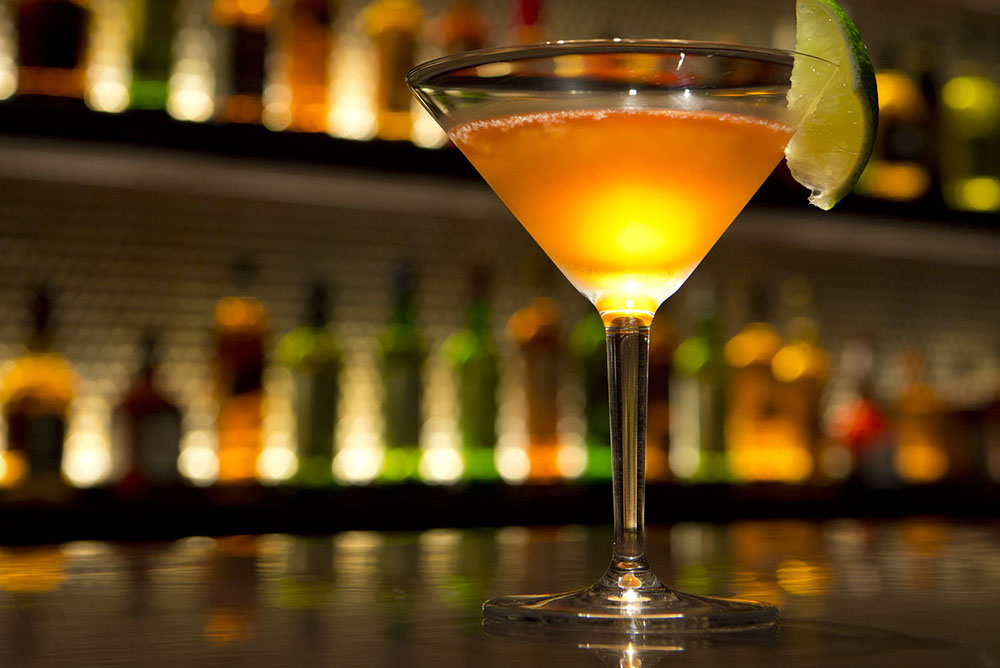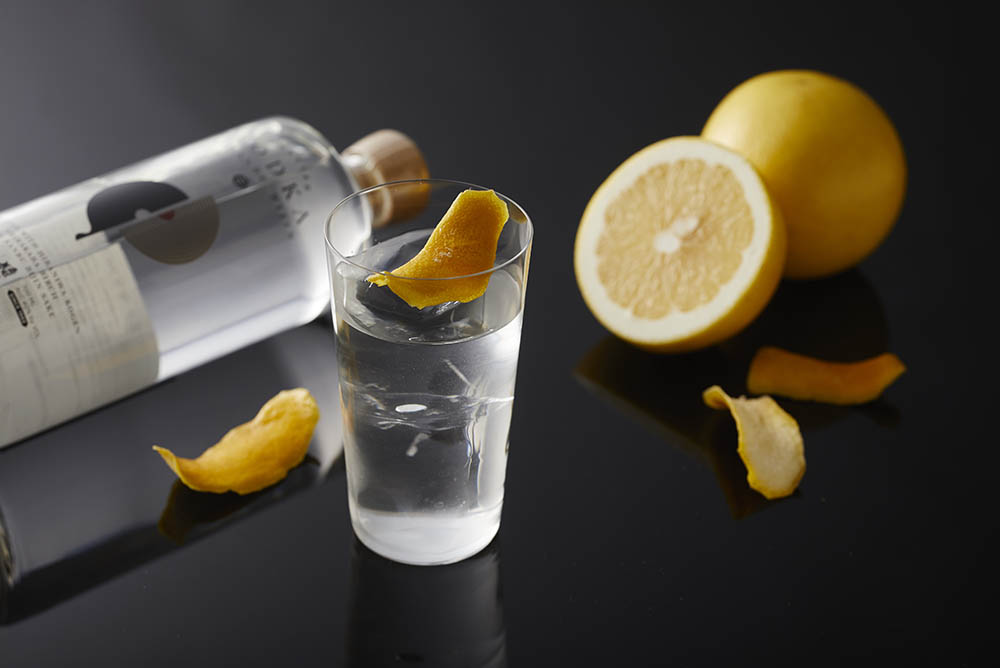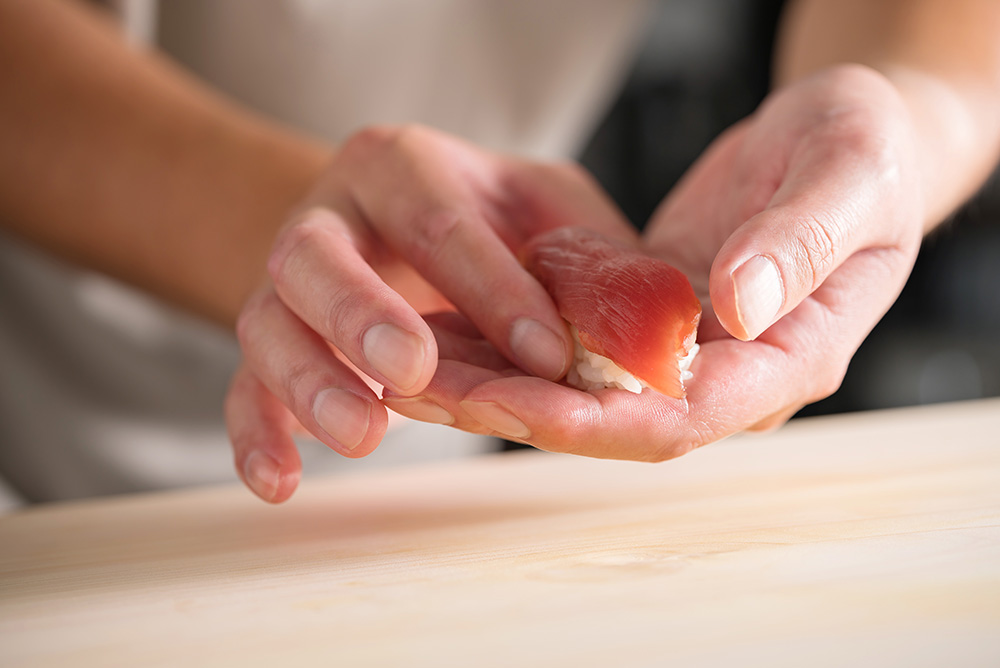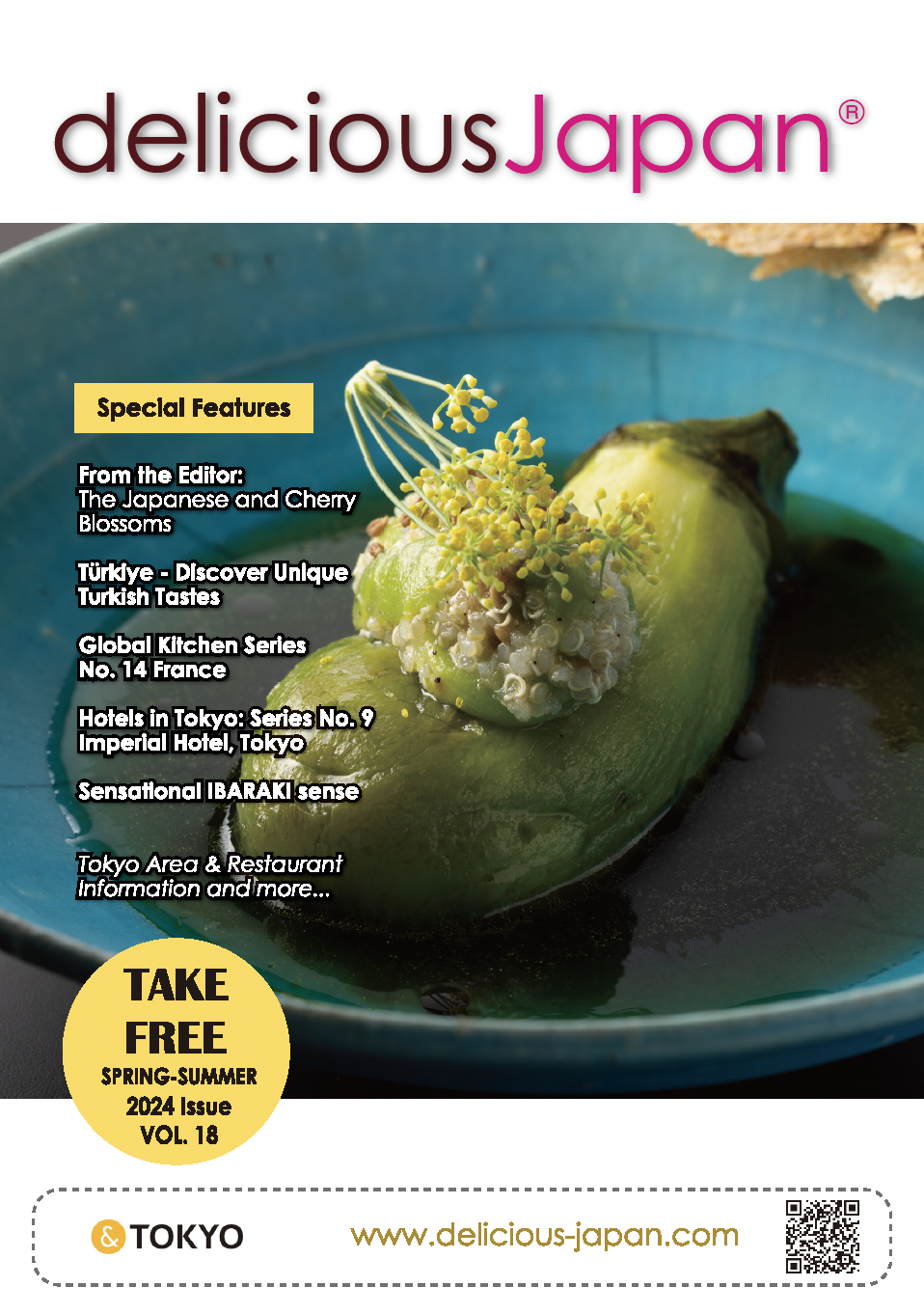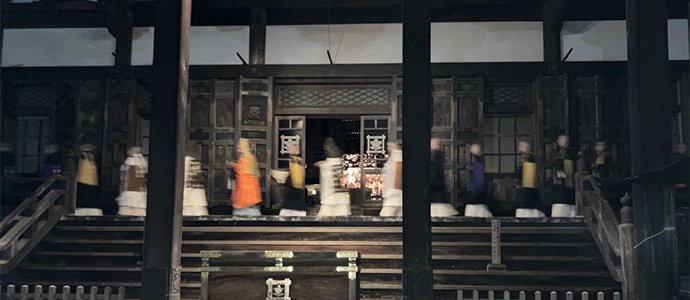
One-Night Two-Day Yamanashi Tour
Words and photos by Patricia Yarrow
DAY 1
14 December 2023 – warm, sunny, blue skies
Helicopter ride from Kai, near Kofu
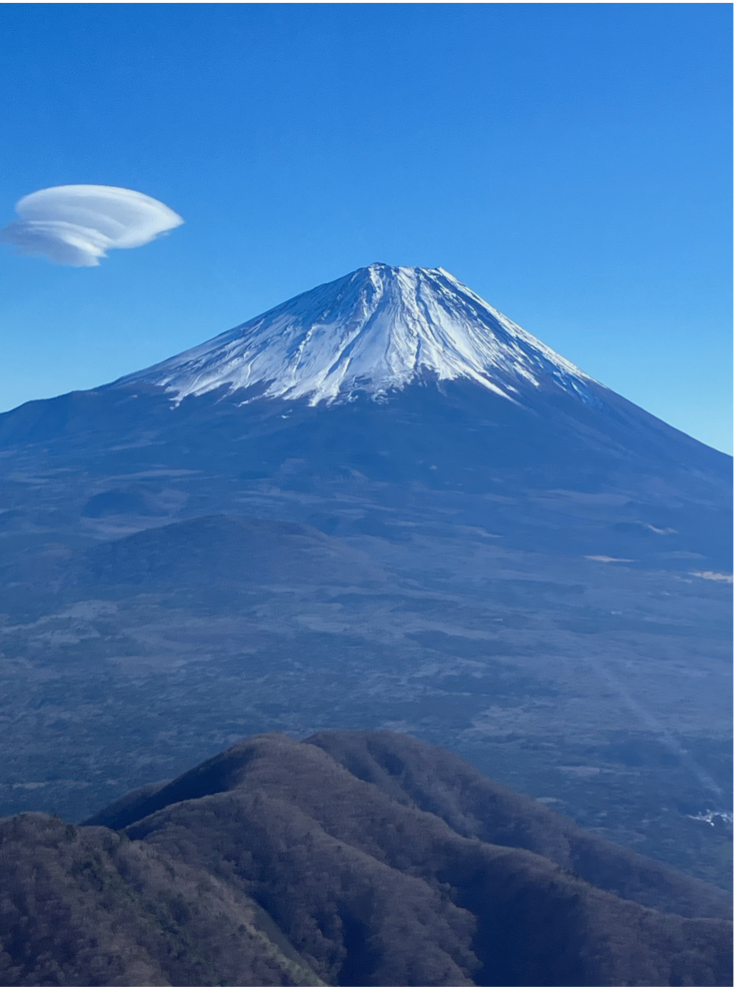
In the skies with Fuji-san
From deep within the canyons of Shinjuku, the morning Shinkansen effortlessly shot to its destination in far-off Kofu, the capital of Yamanashi. Racing through urban concrete corrugations, the landscape morphed into winter fields lined with hand-placed boulders. The familiar Tokyo face of Mount Fuji was slingshot around to the other side. Rhythmic commuting silence was replaced by the whirring of…overhead helicopter blades! My co-pilot seat trembled in all directions as the pilot deftly lifted off the grounds of a repurposed Japanese military airfield, now the training ground of the Japan Aviation Academy, and into the glass-like azure skies. The rugged hills dropped below and escorted our metal bird towards the snowy conical cap of Fuji, placidly sporting a serene guard of two UFO-like clouds. Flying face-to-face with the iconic triangle was a mesmerizing moment.
Japan Aviation Academy:Wild deer game at Yamawarau
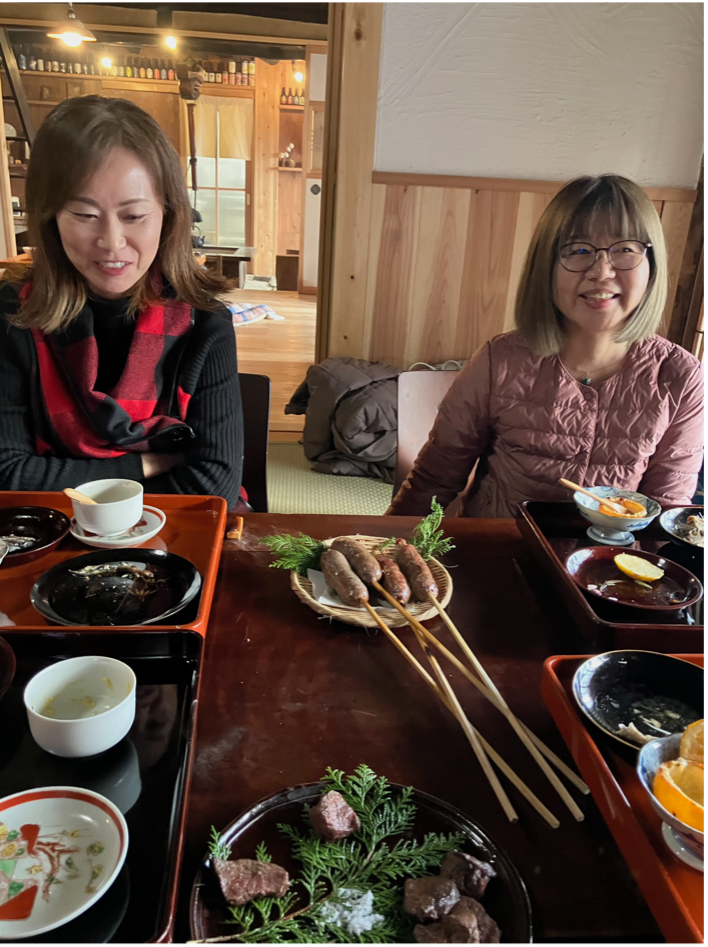
Two friends discuss the remains of the country cuisine and “gibier” (French for “wild game meat”), “prey”) deer.
From the jostling aerial ride, a safe landing onto tatami mats in a beautifully refurbished Japanese traditional country house for lunch at the euphoniously named Yamawarau (Mountain Laughs). Hunters in the local forests bring back wild deer, which become thick steaks and plump deer sausages. Remarkably spacious, with a kid’s playroom to the side, this family-friendly former silkworm nursery and family home features an Iroha-style hearth, perfect for warming chilled hands and toasting spears of river fish.
Website: Photographs visually describe the renovation; text is all Japanese. The full-grown wild pig must have wandered in later and fiercely oversees the upstairs former silkworm sericulture loft.Yamanashi game and “gibier” explained in English
Yamawarau Teuchizawa ヤマワラウ手打沢
Address: 537 Teuchizawa, Minobu-cho, Minamikoma-gun, Yamanashi 409-3302
〒409-3302 山梨県南巨摩郡身延町手打沢537
Phone: 080-2144-6523
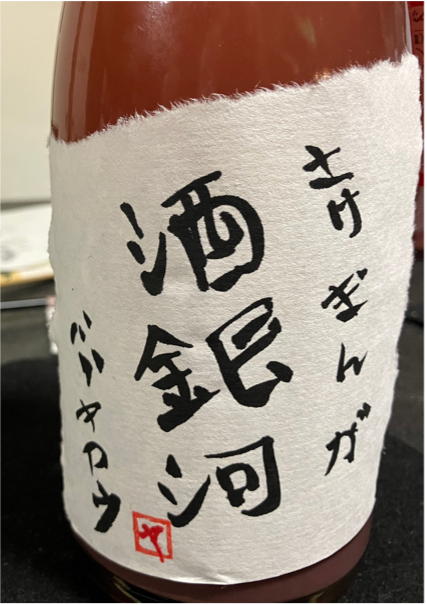
“Sake Galaxy” sake ginga label
Fully as stuffed as that wild pig, the evening settled into the sprawling hallways and familiar traditional Japanese architecture of the shukubo, or temple lodge, of Kuakurinbo “guest villa” in nearby Minobu.
Kakurinbo website, in English
Presented with washi paper, armed with ink and brush, it was time to create a label for a bottle of “Aka Piquette” from Wine Earth, a local wine with a soft landing of 5%. The magic of applying ink to paper is that the brush has a mind of its own. The label I dreamed up was “ 酒銀河” ginga (sake galaxy), perhaps inspired by the night sky and the many sake breweries throughout Yamanashi. The collaboration/battle between the inky brush, paper, and my amused attempts found their new home and were pasted onto the Domaine Hide bottle.
All too soon, it was time for the evening meal of imaginatively plated Buddhist cuisine. The local yuba tofu “bean curd robes” is the star here, and as fiery jets of gas warmed our dinner bowls, we were startled by a blast of taiko drumming by two local lasses. With the Japanese garden in attendance, we had to admire their energy.
The evening concluded with a dip in the nearby bathing facility featuring a fragrant and enticingly circular hot onsen bath. Retreating to my rustic tatami-matted room, closing the fusuma sliding doors, the evening birds twittered into my dreams.
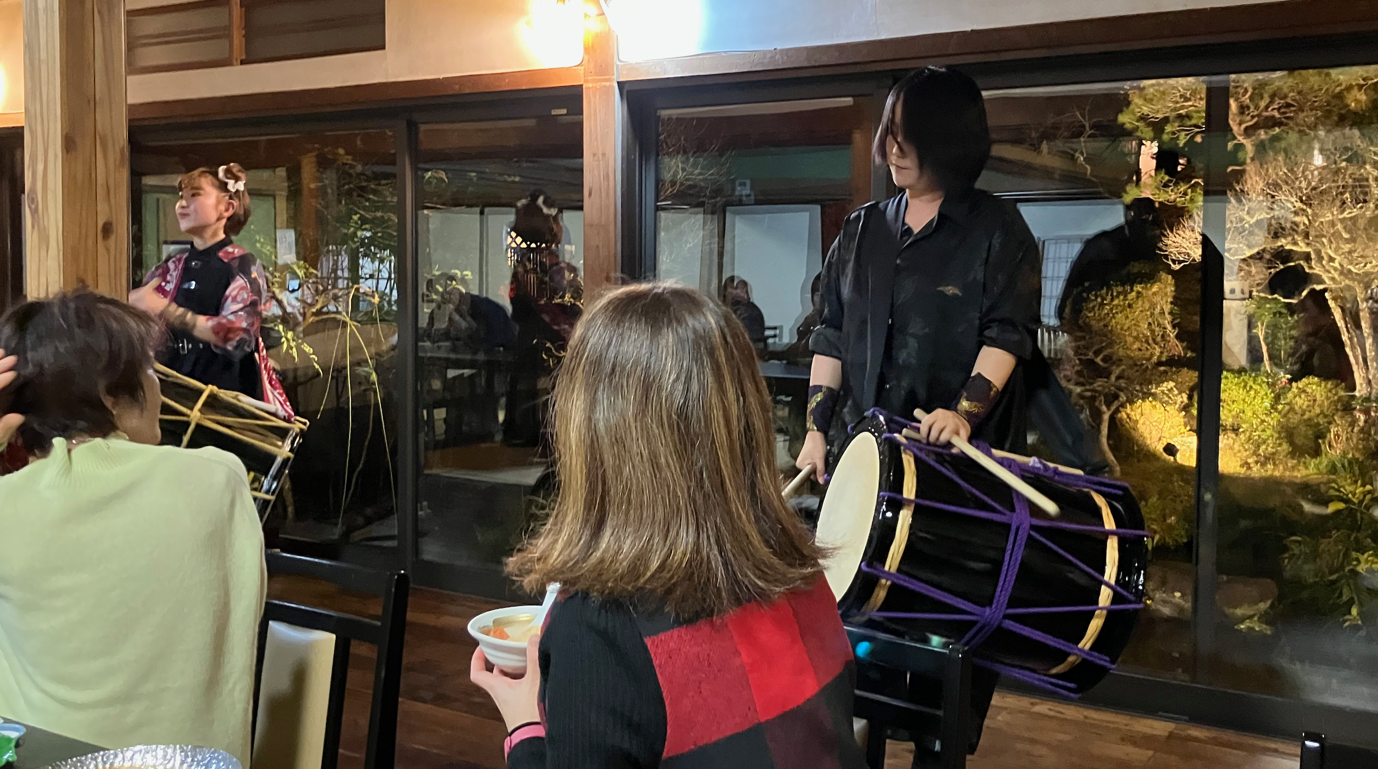
Taiko blast
DAY 2
15 December 2023 -chilly, cloudy, drizzling rain in Minobusan, a mountain village
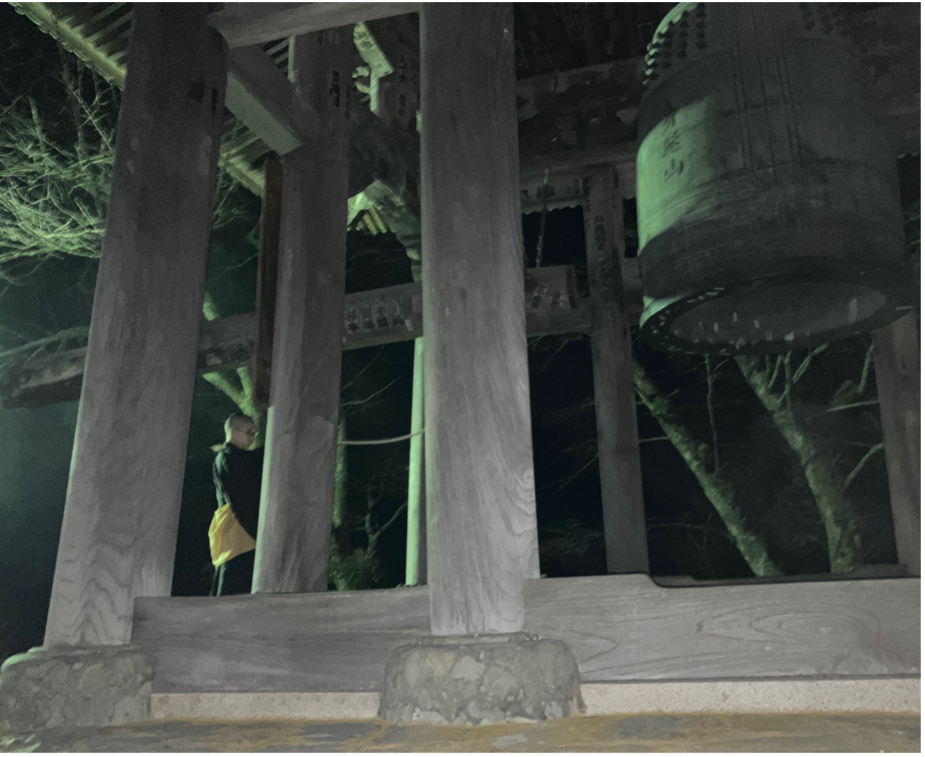
Pre-dawn battle between a slight young monk and an implacable bronze bell.
Predawn stair climbing commenced with the 287 knee-high stony steps of Bodaitei (1652) ascending with a light sprinkle, courtesy of the towering forests. Greeted by an open expanse of Kuonji, enclosed by a large gathering of impressive temple architecture, the estate of the Nichirenshu Buddhist headquarters (est. 1274) prepared for the day. First, a rather magnificent bell-bonging ensued, at 5:30 a.m., conducted by a ballet-dancer of a young monk.
Suitably awoken, monks made their stately way across the elevated exterior hallways and into their seated positions with the glittering golden main hall for a long session of rhythmic chanting.
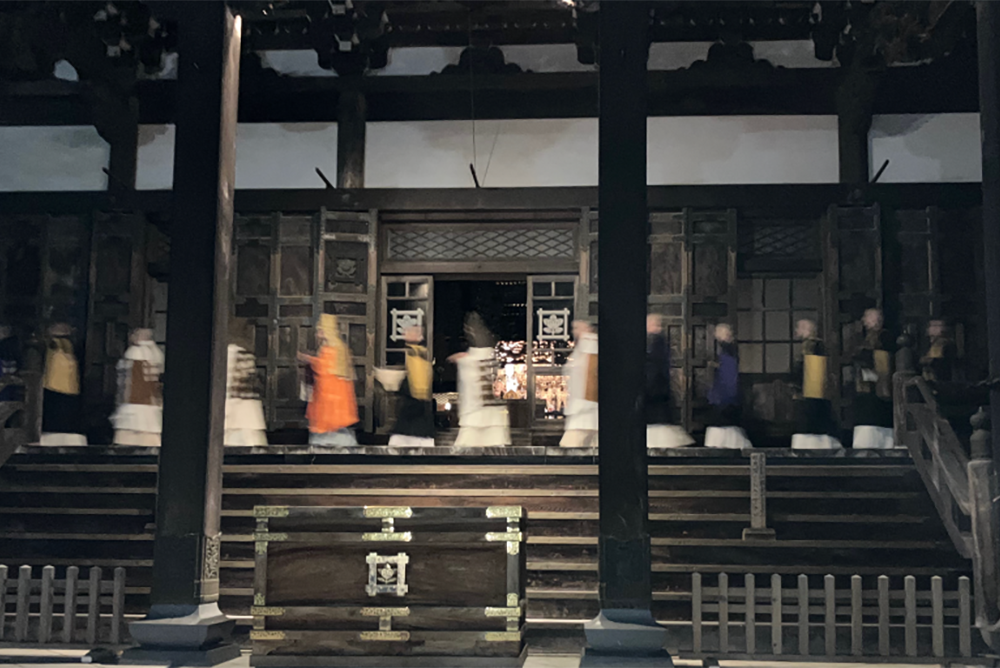
Dawn is still a dream as the long line of ghostly young monks and their senior transit from sleeping quarters to the golden main hall of Gyogakuin.
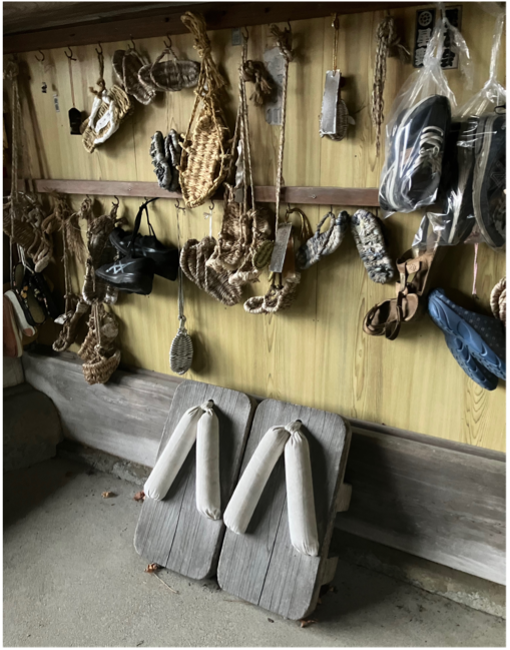
The shoe rack at Sanmon temple gate
The Sanmon temple gate (est. 1642) nearby was at the base of the early morning stairs, and as the skies lightened through the thin clouds and drizzle, an odd sight that at first appeared to be a hap hazardous Lost & Found wall hanging with various footwear. Not quite. This is a site for people to petition for healing of weary feet, speedier athletic races, and perhaps better shoes, perfectly placed before starting in on those mighty stone stairs.
Nearby Gobyosho, the Nichiren Founder’s Mausoleum settles on a mossy, sleepy hillside. Octagonal stone towers mark the tombs enshrining previous Nichiren head priests for eternity.
On this damp morning, the mood was suitably quiet, even reverential. The very trees seemed to be lifting their branches skyward in praise and protection of those founders and stalwarts who continued the Nichiren practices and traditions.
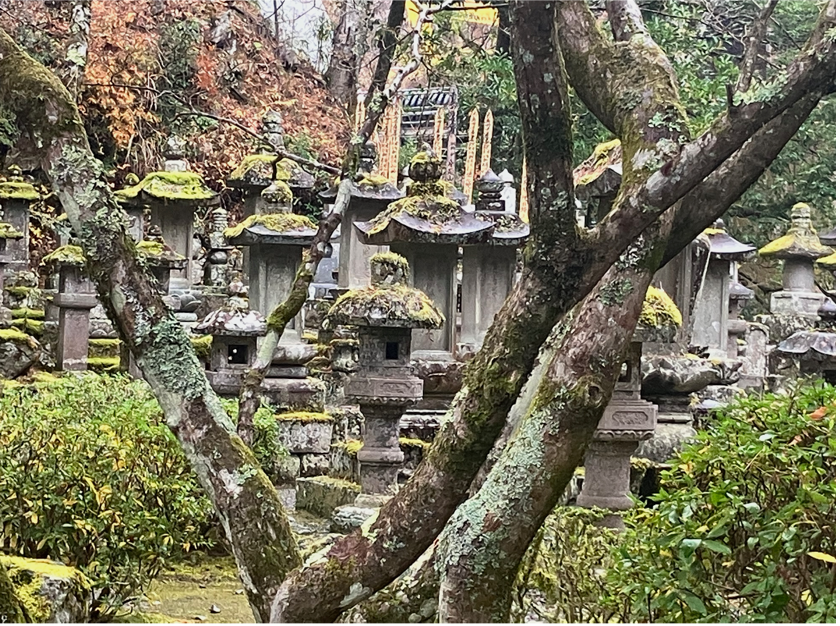
Gobyosho, also near Gosoanato, in the Kuonji Temple area, founded by Nichiren and the final resting places of Nichiren and his successors.
Kuonji website in English
Yamanashi Tourism website in English
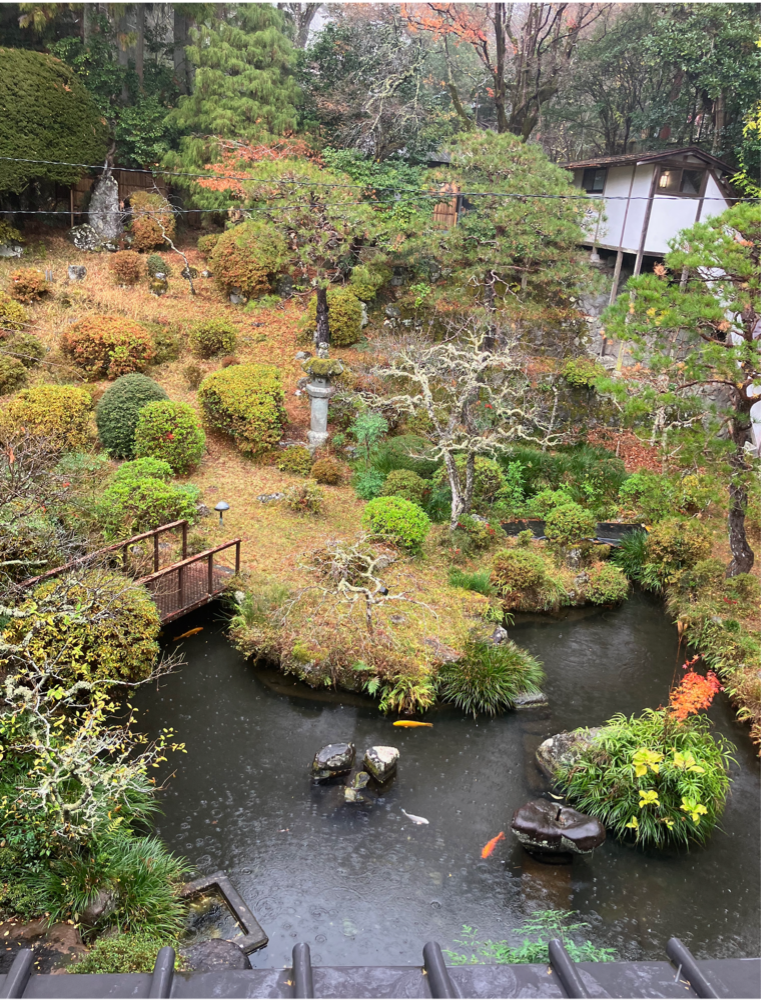
View from my second-floor tatami-matted room
Eyeing the languid passages of the chilled koi, and admiring the design by Muso Kokushi (1275-1351), I imagined all the people in the world who would love to stand next to me and find refuge in this poetic marvel.
Keeping this quiet moment close, a wood-carving event proved that others are daruma-driven at creating the face on their pine orbs. My clumsy hacking away provided the reward of watching the young master carvers couple expertly smooth the edges and bring out the face.
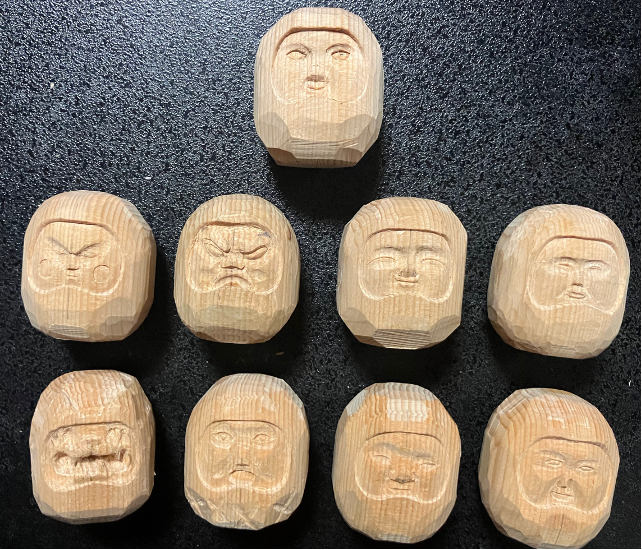
Wood carving results. Mine is next to the cat, and we are quite a pair.
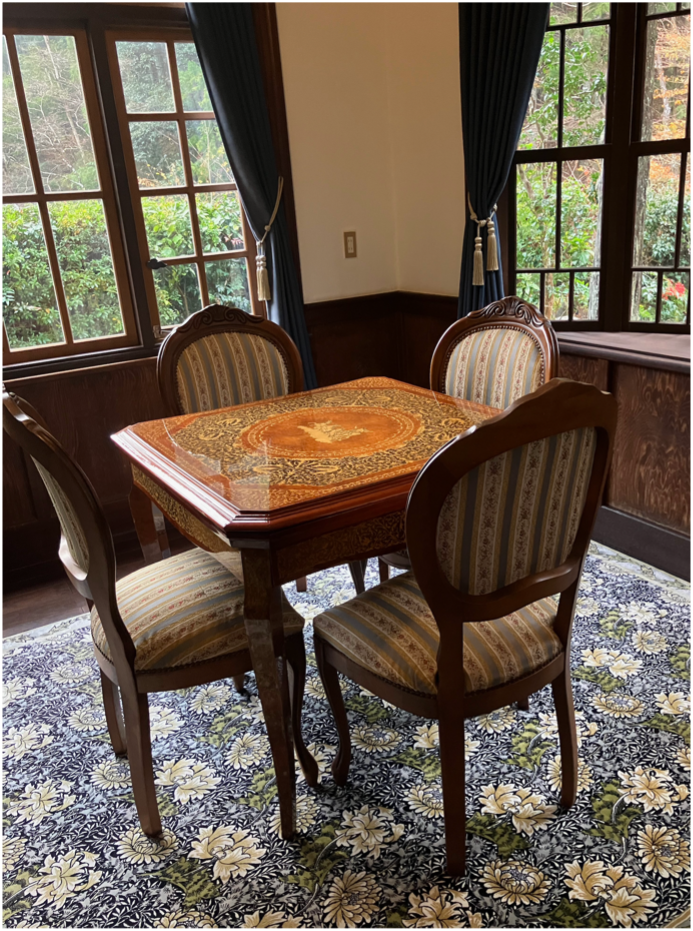
Fine European dining and mahjong gaming room, the perfect combination.
Lunch was at Ebisuya along the main street, featuring local hōtō, which are udon noodles rolled flat. This small room near the doorway caught my final attention on the way out and back to Tokyo, with its salute to the glories of European dining furniture and a magnificent rug. Promises of further Yamanashi adventures await just outside the window.
Ebisuya website in English

